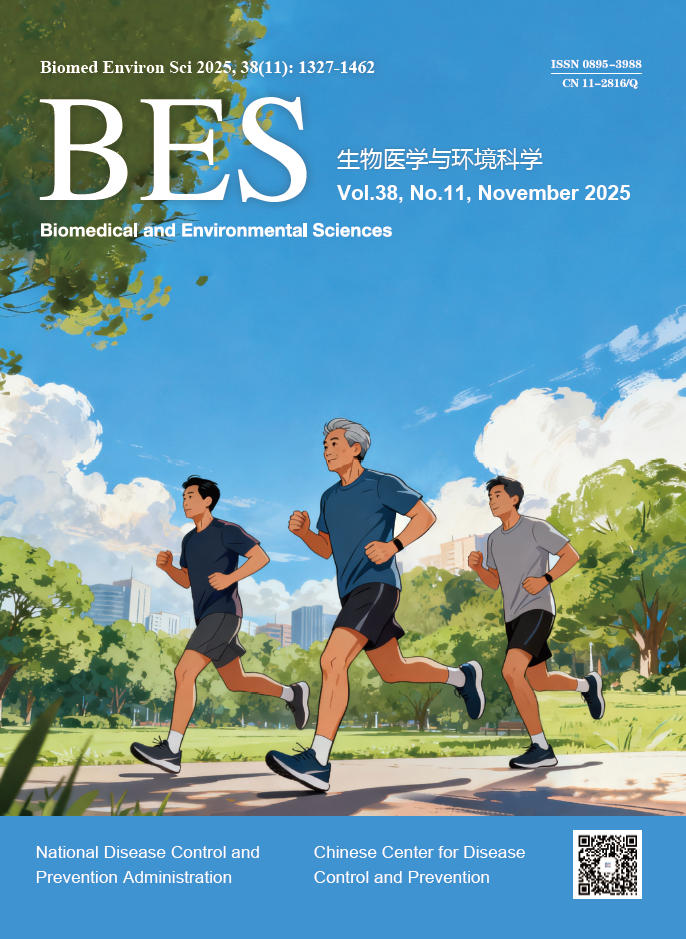Most Download
1
Report on Cardiovascular Health and Diseases in China 2023: An Updated Summary
(30 day view times: 81)
2024, 37(9): 949-992.
doi: 10.3967/bes2024.162
Since 1990, China has made considerable progress in resolving the problem of “treatment difficulty” of cardiovascular diseases (CVD). The prevalent unhealthy lifestyle among Chinese residents has exposed a massive proportion of the population to CVD risk factors, and this situation is further worsened due to the accelerated aging population in China. CVD remains one of the greatest threats to the health of Chinese residents. In terms of the proportions of disease mortality among urban and rural residents in China, CVD has persistently ranked first. In 2021, CVD accounted for 48.98% and 47.35% of deaths in rural and urban areas, respectively. Two out of every five deaths can be attributed to CVD. To implement a national policy “focusing on the primary health institute and emphasizing prevention” and truly achieve a shift of CVD prevention and treatment from hospitals to communities, the National Center for Cardiovascular Diseases has organized experts from relevant fields across China to compile the “Report on Cardiovascular Health and Diseases in China” annually since 2005. The 2024 report is established based on representative, published, and high-quality big-data research results from cross-sectional and cohort population epidemiological surveys, randomized controlled clinical trials, large sample registry studies, and typical community prevention and treatment cases, along with data from some projects undertaken by the National Center for Cardiovascular Diseases. These firsthand data not only enrich the content of the current report but also provide a more timely and comprehensive reflection of the status of CVD prevention and treatment in China.
2
Association of Body Mass Index with All-Cause Mortality and Cause-Specific Mortality in Rural China: 10-Year Follow-up of a Population-Based Multicenter Prospective Study
(30 day view times: 53)
2025, 38(10): 1179-1193.
doi: 10.3967/bes2025.128
3
Impact of PCSK9 Inhibitor Recaticimab on Hyperlipidemia and Plasma Glucose: A Randomized, Double-Blind, Placebo-Controlled Phase 1b/2 Study
(30 day view times: 32)
2025, 38(10): 1246-1254.
doi: 10.3967/bes2025.123
4
Report on Cardiovascular Health and Diseases in China 2022: an Updated Summary
(30 day view times: 30)
2023, 36(8): 669-701.
doi: 10.3967/bes2023.106
In the past 30 years, the accessibility and quality index of medical care have made remarkable progress in China, ranking the first among middle-income countries. Many cardiovascular technologies are at or near the world's leading level, and significant progress has been achieved in China solving the problem of “treatment difficulty” of cardiovascular diseases (CVD). However, due to the prevalence of unhealthy lifestyles among Chinese residents, a huge population with CVD risk factors, accelerated population aging, and other reasons, the incidence and mortality rate of CVD are still increasing, and the turning point of the decline in disease burden has not appeared yet in China. In terms of proportions of disease mortality among urban and rural residents, CVD still ranks the first. In 2020, CVD accounted for 48.00% and 45.86% of the causes of death in rural and urban areas, respectively; two out of every five deaths were due to CVD. It is estimated that the number of current CVD patients in China is around 330 million, including 13 million stroke, 11.39 million coronary heart disease, 8.9 million heart failure, 5 million pulmonary heart disease, 4.87 million atrial fibrillation, 2.5 million rheumatic heart disease, 2 million congenital heart disease, 45.3 million peripheral artery disease, and 245 million hypertension cases. China has entered a new stage of transformation from high-speed development to high-quality development, and the prevention and control of CVD in China should also shift from previous emphasis on scale growth to strategies focusing more on strategic and key technological development in order to curb the trend of increasing incidence and mortality rates of CVD.
5
Interpretation of Annual Report on Cardiovascular Health and Diseases in China 2024
(30 day view times: 26)
2025, 38(8): 893-917.
doi: 10.3967/bes2025.099
Cardiovascular diseases (CVD) and their risk factors are exerting an increasingly significant impact on public health, and the incidence rate of CVD continues to rise. This article provides an interpretation of essentials from the newly published Annual Report on Cardiovascular Health and Diseases in China (2024), aiming to offer scientific evidence for CVD prevention, treatment, and the formulation of relevant policies.
6
Climate-Sensitive Infectious Diseases under Global Climate Change
(30 day view times: 26)
2025, 38(9): 1129-1141.
doi: 10.3967/bes2025.077
Climate and weather significantly influence the duration, timing, and intensity of disease outbreaks, reshaping the global landscape of infectious diseases. Rising temperatures and shifts in precipitation patterns driven by climate change can directly impact the survival and reproduction of pathogens and vector organisms. Moreover, climate change is expected to exacerbate extreme weather events, including floods and droughts, which can disrupt infrastructure and increase the risk of water- and foodborne diseases. There are potential shifts in the temporal and spatial patterns of infectious disease transmission owing to climate change. Furthermore, climate change may alter the epidemiology of vaccine-preventable diseases. These climatic variations not only affect the ecological characteristics of pathogens and vectors but also indirectly influence human behaviors and socioeconomic conditions, further amplifying disease transmission risks. Addressing this challenge requires an interdisciplinary collaboration and comprehensive public health strategies. This review aims to synthesize the current evidence on the impact of climate change on climate-sensitive infectious diseases and elucidate the underlying mechanisms and transmission pathways. Additionally, we explored adaptive policy strategies to mitigate the public health burden of infectious diseases in the context of climate change, offering insights for global health governance and disease control efforts.
7
Dietary Guide for Hyperuricemia and Gout Patients (WS/T 560—2017)
(30 day view times: 22)
2023, 36(9): 897-898.
doi: 10.3967/bes2023.118
9
Evidence on Invasion of Blood, Adipose Tissues, Nervous System and Reproductive System of Mice After a Single Oral Exposure: Nanoplastics versus Microplastics
(30 day view times: 20)
2022, 35(11): 1025-1037.
doi: 10.3967/bes2022.131
10
Effects of Oral Vitamin D Supplementation on Vitamin D Levels and Glycemic Parameters in Patients with Type 2 Diabetes Mellitus: A Systematic Review and Network Meta-Analysis
(30 day view times: 19)
2025, 38(6): 716-726.
doi: 10.3967/bes2025.066
11
Effect of Home Blood Pressure Telemonitoring Plus Additional Support on Blood Pressure Control: A Randomized Clinical Trial
(30 day view times: 19)
2023, 36(6): 517-526.
doi: 10.3967/bes2023.063
12
Deciphering the Role of VIM, STX8, and MIF in Pneumoconiosis Susceptibility: A Mendelian Randomization Analysis of the Lung-Gut Axis and Multi-Omics Insights from European and East Asian Populations
(30 day view times: 18)
2025, 38(10): 1270-1286.
doi: 10.3967/bes2025.028
13
Benefits of Mindfulness Training on the Mental Health of Women During Pregnancy and Early Motherhood: A Randomized Controlled Trial
(30 day view times: 18)
2023, 36(4): 353-366.
doi: 10.3967/bes2023.041
14
Trends in Lipids Level and Dyslipidemia among Chinese Adults, 2002-2015
(30 day view times: 17)
2019, 32(8): 559-570.
doi: 10.3967/bes2019.074
15
Nutrition Guidelines of Complementary Feeding for Infants and Toddlers (WS/T 678—2020)
(30 day view times: 17)
2023, 36(9): 899-901.
doi: 10.3967/bes2023.117
16
Joint Effect of Multiple Air Pollutant Exposure on Dyslipidemia in Chinese Primary School Children
(30 day view times: 17)
2025, 38(10): 1302-1307.
doi: 10.3967/bes2025.130
17
Comparison of the Nerve Regeneration Capacity and Characteristics between Sciatic Nerve Crush and Transection Injury Models in Rats
(30 day view times: 17)
2023, 36(2): 160-173.
doi: 10.3967/bes2023.001
18
NFKBIE: Novel Biomarkers for Diagnosis, Prognosis, and Immunity in Colorectal Cancer: Insights from Pan-cancer Analysis
(30 day view times: 17)
2025, 38(10): 1320-1325.
doi: 10.3967/bes2025.124
19
Validation of the Physical Activity Questionnaire for Older Children (PAQ-C) among Chinese Children
(30 day view times: 17)
2016, 29(3): 177-186.
doi: 10.3967/bes2016.022
Objective This study initially validates the Chines eversion of the Physical Activity Questionnaire for Older Children (PAQ-C), which has been identified as a potentially valid instrument to assess moderate-to-vigorous physical activity (MVPA) in children among diverse racial groups. Methods The psychometric properties of the PAQ-C with 742 Hong Kong Chinese children were assessed withthe scale's internal consistency, reliability, test-retest reliability, confirmatory factory analysis (CFA) in the overall sample, and multistep invariance tests across gender groups as well as convergent validity with body mass index (BMI), and an accelerometry-based MVPA. Results The Cronbach alpha coefficient (α=0.79),composite reliability value (ρ=0.81), andthe intraclass correlation coefficient(α=0.82)indicate the satisfactory reliability of the PAQ-C score.The CFA indicated data fit a single factor model, suggesting that the PAQ-C measures only one construct, on MVPA over the previous 7 days.The multiple-group CFAs suggested that the factor loadings and variances and covariances of the PAQ-C measurement model were invariant across gender groups. The PAQ-Cscore was related to accelerometry-based MVPA (r=0.33) and inversely related to BMI (r=-0.18). Conclusion This study demonstrates the reliability and validity of the PAQ-Cin Chinese children.
20
Report on Cardiovascular Health and Diseases in China 2021: An Updated Summary
(30 day view times: 16)
2022, 35(7): 573-603.
doi: 10.3967/bes2022.079
In 2019, cardiovascular disease (CVD) accounted for 46.74% and 44.26% of all deaths in rural and urban areas, respectively. Two out of every five deaths were due to CVD. It is estimated that about 330 million patients suffer from CVD in China. The number of patients suffering from stroke, coronary heart disease, heart failure, pulmonary heart disease, atrial fibrillation, rheumatic heart disease, congenital heart disease, lower extremity artery disease and hypertension are 13.00 million, 11.39 million, 8.90 million, 5.00 million, 4.87 million, 2.50 million, 2.00 million, 45.30 million, and 245.00 million, respectively. Given that China is challenged by the dual pressures of population aging and steady rise in the prevalence of metabolic risk factors, the burden caused by CVD will continue to increase, which has set new requirements for CVD prevention and treatment and the allocation of medical resources in China. It is important to reduce the prevalence through primary prevention, increase the allocation of medical resources for CVD emergency and critical care, and provide rehabilitation services and secondary prevention to reduce the risk of recurrence, re-hospitalization and disability in CVD survivors. The number of people suffering from hypertension, dyslipidemia and diabetes in China has reached hundreds of millions. Since blood pressure, blood lipids, and blood glucose levels rise mostly insidiously, vascular disease or even serious events such as myocardial infarction and stroke often already occured at the time of detection in this population. Hence, more strategies and tasks should be taken to prevent risk factors such as hypertension, dyslipidemia, diabetes, obesity, and smoking, and more efforts should be made in the assessment of cardiovascular health status and the prevention, treatment, and research of early pathological changes.




















 Quick Links
Quick Links